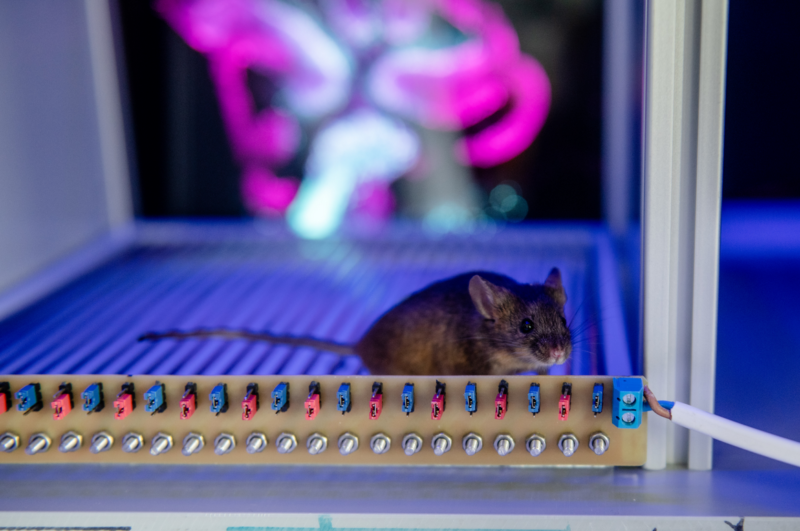
A21 - Cerebellar contribution to fear extinction
Melanie Mark
One of the key elements to survival is the ability of our brain to recall threatening situations from the past so our self-defense mechanism can respond swiftly. Cerebellar lesion and stimulation studies in rodents and humans suggest a contribution of the cerebellum to anxiety and fear extinction behavior. However, a clear understanding of the circuitry and learning mechanisms within the cerebellum contributing to fear extinction is missing. Thus, the goal of this project is to investigate the cerebellar contribution and its intrinsic mechanisms to fear extinction in wildtype and cerebellar degenerative mouse models for episodic ataxia type 2 (EA2) and spinocerebellar ataxia type 6 (SCA6). We will attempt to rescue fear conditioning, extinction or retrieval deficits with optogenetic, chemogenetic and pharmacological strategies in the next funding period.
Guiding questions of A21:
- What regions and cell types of the cerebellum are active during the different phases of fear extinction?
- Can we control (i. e. delay or accelerate) fear extinction from the cerebellar cortex or deep cerebellar nuclei using optogenetics?
- How is the cerebellum involved in prediction errors during fear extinction?
- Do our cerebellar degenerative mouse models for EA2 and SCA6 display deficits in fear conditioning, retrieval or extinction? Can we rescue these deficits in EA2 and SCA6 mice with optogenetic strategies?

10 project relevant publications
Batsikadze G*, Pakusch J*, Klein M, Ernst TM, Thieme A, Nicksirat SA, Steiner KM, Nio E, Genç E, Maderwald S, Deuschl C, Merz CJ, Quick HH, Mark MD*, Timmann D*. (2024) Mild Deficits in Fear Learning: Evidence from Humans and Mice with Cerebellar Cortical Degeneration. eNeuro. Feb 26;11(2): ENEURO.0365-23.2023. https://doi.org/10.1523/ENEURO.0365-23.2023
Bihorac J, Salem Y, Lückemann L, Schedlowski M, Doenlen R, Engler H, Mark MD, Dombrowski K, Spoida K, Hadamitzky M. (2024) Investigations on the ability of the insular cortex to process peripheral immunosuppression. Journal of Neuroimmune Pharmacology. Jul 30;19(1):40. https://doi.org/10.1007/s11481-024-10143-9
Bohne P, Josten M, Rambuscheck L, Zhu XR, Rybarski MO, Mark MD (2023) Cerebellar α1D-adrenergic receptors mediate stress-induced dystonia in totteringtg/tg mice. bioRxiv11.12.566757. https://doi.org/10.1101/2023.11.12.566757
Bohne P, Schwarz MK, Herlitze S, Mark MD (2019) A New Projection from the Deep Cerebellar Nuclei to the Hippocampus via the Ventrolateral and Laterodorsal Thalamus in Mice. Front Neural Circuits 13: 51. https://doi.org/10.3389/fncir.2019.00051
Ernst TM, Brol AE, Gratz M, Ritter C, Bingel U, Schlamann M, Maderwald S, Quick HH, Merz CJ, Timmann D. (2019) The cerebellum is involved in processing of predictions and prediction errors in a fear conditioning paradigm. Elife 8:e46831. https://doi.org/10.7554/eLife.46831
Karapinar R# , Schwitalla JC# , Eickelbeck D# , Pakusch J, Mücher B, Grömmke M, Surdin T, Knöpfel T, Mark MD*, Siveke I, Herlitze S* (2021) Reverse optogenetics of G protein signaling by zebrafish non-visual opsin Opn7b for synchronization of neuronal networks. Nature Commun. Jul 23;12(1):4488. *Equal corresponding author. https://doi.org/10.1038/s41467-021-24718-0
Mark M, Pakusch J, Ernst TM, Timmann D (2022). Cerebellum and Emotion Memory. In: Adamaszek, M., Manto, M., Schutter, D.J.L.G. (eds) The Emotional Cerebellum. Advances in Experimental Medicine and Biology, vol 1378. Springer, Cham. https://doi.org/10.1007/978-3-030-99550-8_5
Nio E, Pais Pereira P, Diekmann N, Petrenko M, Doubliez A, Ernst TM, Batsikadze G, Maderwald S, Deuschl C, Üngör M, Cheng S, Merz CJ, Quick HH, Timmann D (2025) Human cerebellum and ventral tegmental area interact during extinction of learned fear. eLife 14:RP105399. https://doi.org/10.7554/eLife.105399
Piotrowski D, Clemensson EKH, Nguyen HP, Mark MD. (2024) Phenotypic analysis of ataxia in spinocerebellar ataxia type 6 mice using DeepLabCut. Sci Rep. 14:8571. https://doi.org/10.1038/s41598-024-59187-0
Surdin T, Preissing B, Rohr L, Grömmke M, Böke H, Barcik M, Zohre A, Jancke D, Herlitze S, Mark MD, Siveke I (2023) Optogenetic activation of mGluR1 signaling in the cerebellum induces synaptic plasticity. iScience. 26:105828. https://doi.org/10.1016/j.isci.2022.105828


